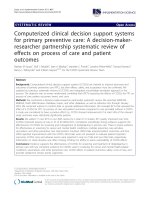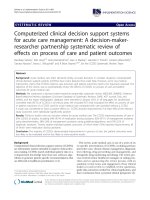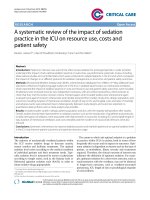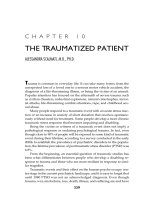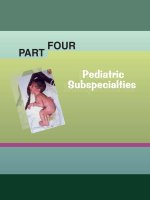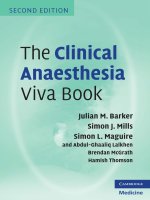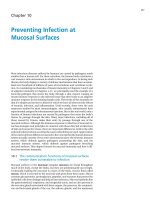Ebook The ABSITE review (4/E): Part 2
Bạn đang xem bản rút gọn của tài liệu. Xem và tải ngay bản đầy đủ của tài liệu tại đây (13.58 MB, 273 trang )
CHAPTER 25.
THORACIC
ANATOMY AND PHYSIOLOGY
Azygous vein runs along the right side and dumps into superior vena cava
Thoracic duct runs along the right side, crosses midline at T4–5, and dumps into left subclavian
vein at junction with internal jugular vein
Phrenic nerve – runs anterior to hilum
Vagus nerve – runs posterior to hilum
Right lung volume 55% (3 lobes: RUL, RML, and RLL)
Left lung volume 45% (2 lobes: LUL and LLL and lingula)
Quiet inspiration – diaphragm 80%, intercostals 20%
Greatest change in dimension superior/inferior
Accessory muscles – sternocleidomastoid muscle (SCM), levators, serratus posterior, scalenes
Type I pneumocytes – gas exchange
Type II pneumocytes – surfactant production
Pores of Kahn – direct air exchange between alveoli
PULMONARY FUNCTION TESTS
Need predicted postop FEV1 > 0.8 (or > 40% of the predicted postop value)
• If it is close → get qualitative V/Q scan to see contribution of that portion of lung to overall
FEV1 → if low, may still be able to resect
Need predicted postop DLCO > 10 mL/min/mm Hg CO (or > 40% of the predicted postop value)
• Measures carbon monoxide diffusion and represents oxygen exchange capacity
• This value depends on pulmonary capillary surface area, hemoglobin content, and alveolar
architecture
No resection if preop pCO2 > 50 or pO2 < 60 at rest
No resection if preop VO2 max < 10–12 mL/min/kg (maximum oxygen consumption)
Persistent air leak – most common after segmentectomy/wedge
Atelectasis – most common after lobectomy
Arrhythmias – most common after pneumonectomy
LUNG CANCER
Symptoms: can be asymptomatic with finding on routine CXR; cough, hemoptysis, atelectasis, PNA,
pain, weight loss
Most common cause of cancer-related death in the United States
Nodal involvement has strongest influence on survival
Brain – single most common site of metastasis
• Can also go to supraclavicular nodes, other lung, bone, liver, and adrenals
Recurrence usually appears as disseminated metastases
• 80% of recurrences are within the 1st 3 years
Lung CA overall 5-year survival rate 10%; 30% with resection for cure
Stage I and II disease resectable; T3,N1,M0 (stage IIIa) possibly resectable
Lobectomy or pneumonectomy most common procedure; sample suspicious nodes
Non–small cell carcinoma
• 80% of lung CA
• Squamous cell carcinoma usually more central
• Adenocarcinoma usually more peripheral
• Adenocarcinoma is the most common lung CA (not squamous)
TNM STAGING SYSTEM FOR LUNG CANCER
• T1: < 3 cm. T2: > 3 cm but > 2 cm away from carina. T3: invasion of chest wall, pericardium,
diaphragm, or < 2 cm from carina. T4: mediastinum, esophagus, trachea, vertebra, heart, great
vessels, malignant effusion (all indicate unresectability)
• N1: ipsilateral hilum nodes. N2: ipsilateral mediastinal or subcarinal (unresectable).
• N3: contralateral mediastinal or supraclavicular (unresectable)
• M1: distant metastasis
Small cell carcinoma
• 20% of lung CA; neuroendocrine in origin
• Usually unresectable at time of diagnosis (< 5% candidates for surgery)
• Overall 5-year survival rate < 5% (very poor prognosis)
• Stage T1,N0,M0 5-year survival rate – 50%
• Most get just chemo-XRT
Paraneoplastic syndromes
• Squamous cell CA – PTH-related peptide
• Small cell CA – ACTH and ADH
• Small cell ACTH – most common paraneoplastic syndrome
Mesothelioma
• Most malignant lung tumor
• Aggressive local invasion, nodal invasion, and distant metastases common at the time of
diagnosis
• Asbestos exposure
Non–small cell CA chemotherapy (stage II or higher) – carboplatin, Taxol
Small cell lung CA chemotherapy – cisplatin, etoposide
XRT can be used for lung CA as well
Chest and abdominal CT scan – single best test for clinical assessment of T and N status
PET scan – best test for M status
Mediastinoscopy
• Use for centrally located tumors and patients with suspicious adenopathy (> 0.8 cm or
subcarinal > 1.0 cm) on chest CT
• Does not assess aorto-pulmonary (AP) window nodes (left lung drainage)
• Assesses ipsilateral (N2) and contralateral (N3) mediastinal nodes
• If mediastinal nodes are positive, tumor is unresectable
• Looking into middle mediastinum with mediastinoscopy
• Left-side structures – RLN, esophagus, aorta, main pulmonary artery (PA)
• Right-side structures – azygous and SVC
• Anterior structures – innominate vein, innominate artery, right PA
Chamberlain procedure (anterior thoracotomy or parasternal mediastinotomy) – assesses enlarged
AP window nodes; go through left 2nd rib cartilage
Bronchoscopy – needed for centrally located tumors to check for airway invasion
For lung CA, patients need to 1) be operable (eg have appropriate FEV1 and DLCO values) and 2)
be resectable (ie can’t have T4, N2, N3, or M disease)
Pancoast tumor – tumor invades apex of chest wall and patients have Horner’s syndrome
(invasion of sympathetic chain → ptosis, miosis, anhidrosis) or ulnar nerve symptoms
Coin lesion
• Overall, 10% are malignant
• Age < 50 → < 5% malignant; age > 50 → > 50% malignant
• No growth in 2 years, and smooth contour suggests benign disease
• If suspicious, will need either guided biopsy or wedge resection
Asbestos exposure increases lung CA risk 90X
Bronchoalveolar CA – can look like pneumonia; grows along alveolar walls; multifocal
Metastases to the lung – if isolated and not associated with any other systemic disease, may be
resected for colon, renal cell CA, sarcoma, melanoma, ovarian, and endometrial CA
CARCINOIDS
Neuroendocrine tumor, usually central
• 5% have metastases at time of diagnosis; 50% have symptoms (cough, hemoptysis)
Typical carcinoid – 90% 5-year survival rate
Atypical carcinoid – 60% 5-year survival
Tx: resection; treat like cancer; outcome closely linked to histology
Recurrence increased with positive nodes or tumors > 3 cm
BRONCHIAL ADENOMAS
Mucoepidermoid adenoma, mucous gland adenoma, and adenoid cystic adenoma → all are
malignant tumors
Mucoepidermoid adenoma and mucous gland adenoma
• Slow growth, no metastases
• Tx: resection
Adenoid cystic adenoma
• From submucosal glands; spreads along perineural lymphatics, well beyond endoluminal
component; very XRT sensitive
• Slow growing; can get 10-year survival with incomplete resection
• Tx: resection; if unresectable, XRT can provide good palliation
HAMARTOMAS
Most common benign adult lung tumor
Have calcifications and can appear as a popcorn lesion on chest CT
Diagnosis can be made with CT
Do not require resection
Repeat chest CT in 6 months to confirm diagnosis
MEDIASTINAL TUMORS IN ADULTS
Most are asymptomatic; can present with chest pain, cough, dyspnea
Neurogenic tumors – most common mediastinal tumor in adults and children, usually in posterior
mediastinum
50% of symptomatic mediastinal masses are malignant
90% of asymptomatic mediastinal masses are benign
Location
• Anterior (thymus) – most common site for mediastinal tumor; T’s →
• Thymoma (#1 anterior mediastinal mass in adults)
• Thyroid CA and goiters
• T-cell lymphoma
• Teratoma (and other germ cell tumors)
• Parathyroid adenomas
• Middle (heart, trachea, ascending aorta)
• Bronchiogenic cysts
• Pericardial cysts
• Enteric cysts
• Lymphoma
• Posterior (esophagus, descending aorta)
• Enteric cysts
• Neurogenic tumors
• Lymphoma
Thymoma
• All thymomas require resection
• Thymus too big or associated with refractory myasthenia gravis → resection
• 50% of thymomas are malignant
• 50% of patients with thymomas have symptoms
• 50% of patients with thymomas have myasthenia gravis
• 10% of patients with myasthenia gravis have thymomas
Myasthenia gravis – fatigue, weakness, diplopia, ptosis; antibodies to acetylcholine receptors
• Tx: anticholinesterase inhibitors (neostigmine); steroids, plasmapheresis
• 80% get improvement with thymectomy, including patients who do not have thymomas
Germ cell tumors
• Need to biopsy (often done with mediastinoscopy)
• Teratoma – most common germ cell tumor in mediastinum
• Can be benign or malignant
• Tx: resection; possible chemotherapy
• Seminoma – most common malignant germ cell tumor in mediastinum
• 10% are beta-HCG positive; should not have AFP (alpha-fetoprotein)
• Tx: XRT (extremely sensitive); chemotherapy reserved only for metastases or bulky nodal
disease; surgery for residual disease after that
• Non-seminoma – 90% have elevated beta-HCG and AFP
• Tx: chemo (cisplatin, bleomycin, VP-16); surgery for residual disease
Cysts
• Bronchiogenic – usually posterior to carina. Tx: resection
• Pericardial – usually at right costophrenic angle. Tx: can leave alone (benign)
Neurogenic tumors – have pain, neurologic deficit. Tx: resection
• 10% have intra-spinal involvement that requires simultaneous spinal surgery
• Neurolemmoma (schwannoma) – most common
• Paraganglioma – can produce catecholamines, associated with von Recklinghausen’s disease
• Can also get neuroblastomas and neurofibromas
TRACHEA
Benign tumors: adults – papilloma; children – hemangioma
Malignant – squamous cell carcinoma
Most common late complication after tracheal surgery – granulation tissue formation
Most common early complication after tracheal surgery – laryngeal edema
• Tx: reintubation, racemic epinephrine, steroids
Post-intubation stenosis – at stoma site with tracheostomy, at cuff site with ET tube
• Serial dilatation, bronchoscopic resection, or laser ablation if minor
• Tracheal resection with end-to-end anastomosis if severe or if it keeps recurring
Tracheo-innominate artery fistula – occurs after tracheostomy, can have rapid exsanguination
• Tx: place finger in tracheostomy hole and hold pressure → median sternotomy with ligation
and resection of innominate artery
• This complication is avoided by keeping tracheostomy above the 3rd tracheal ring
Tracheo-esophageal fistula
• Usually occurs with prolonged intubation
• Place large-volume cuff endotracheal tube below fistula
• May need decompressing gastrostomy
• Attempt repair after the patient is weaned from ventilator
• Tx: tracheal resection, reanastomosis, close hole in esophagus, sternohyoid flap between
esophagus and trachea
LUNG ABSCESS
Necrotic area; most commonly associated with aspiration
Most commonly in the superior segment of RLL
Tx: antibiotics alone (95% successful); CT-guided drainage if that fails
• Surgery if above fails or cannot rule out cancer (> 6 cm, failure to resolve after 6 weeks)
Chest CT can help differentiate empyema from lung abscess
EMPYEMA
Usually secondary to pneumonia and subsequent parapneumonic effusion (staph, strep)
Can also be due to esophageal, pulmonary, or mediastinal surgery
Symptoms: pleuritic chest pain, fever, cough, SOB
Pleural fluid often has WBCs > 500 cells/cc, bacteria, and a positive Gram stain
Exudative phase (1st week) – Tx: chest tube, antibiotics
Fibro-proliferative phase (2nd week) – Tx: chest tube, antibiotics; possible VATS (video-assisted
thoracoscopic surgery) deloculation
Organized phase (3rd week) – Tx: likely need decortication; fibrous peel occurs around lung
• Some are using intra-pleural tPA (tissue plasminogen activator) to try and dissolve the peel
• May need Eloesser flap (open thoracic window – direct opening to external environment) in
frail/elderly
CHYLOTHORAX
Milky white fluid; has ↑ lymphocytes and TAGs (> 110 mL/µL); Sudan red stains fat
Fluid is resistant to infection
50% secondary to trauma or iatrogenic injury
50% secondary to tumor (lymphoma most common, due to tumor burden in the lymphatics)
Injury above T5–6 results in left-sided chylothorax
Injury below T5–6 results in right-sided chylothorax
Tx: 2–3 weeks of conservative therapy (chest tube, octreotide, low-fat diet or TPN)
• If above fails and chylothorax secondary to trauma or iatrogenic injury, need ligation of
thoracic duct on right side low in mediastinum (80% successful)
• For malignant causes, need talc pleurodesis and possible chemo and/or XRT (less successful
than above)
MASSIVE HEMOPTYSIS
> 600 cc/24 h; bleeding usually from high-pressure bronchial arteries
Most commonly secondary to infection, death is due to asphyxiation
Tx: place bleeding side down; mainstem intubation to side opposite of bleeding to prevent drowning
in blood; rigid bronchoscopy to identify site and possibly control bleeding; may need lobectomy or
pneumonectomy to control; bronchial artery embolization if not suitable for surgery
SPONTANEOUS PNEUMOTHORAX
Tall, healthy, thin, young males; more common on the right
Recurrence risk after 1st pneumothorax is 20%, after 2nd pneumothorax is 60%, after 3rd
pneumothorax is 80%
Results from rupture of a bleb usually in the apex of the upper lobe of the lung
Tx: chest tube
Surgery for recurrence, air leak > 7 days, non-reexpansion, high-risk profession (airline pilot, diver,
mountain climber), or patients who live in remote areas
Surgery consists of thoracoscopy, apical blebectomy, and mechanical pleurodesis
OTHER CONDITIONS
Tension pneumothorax – most likely to cause arrest after blunt trauma; impaired venous return
Catamenial pneumothorax – occurs in temporal relation to menstruation
• Caused by endometrial implants in the visceral lung pleura
Residual hemothorax despite 2 good chest tubes → OR for thoracoscopic drainage
Clotted hemothorax – surgical drainage if > 25% of lung, air–fluid levels, or signs of infection
(fever, ↑ WBCs); surgery in 1st week to avoid peel
Broncholiths – usually secondary to infection
Mediastinitis – usually occurs after cardiac surgery
Whiteout on chest x-ray
• Midline shift toward whiteout – most likely collapse → need bronchoscopy to remove plug
• No shift – CT scan to figure it out
• Midline shift away from whiteout – most likely effusion → place chest tube
Bronchiectasis – acquired from infection, tumor, cystic fibrosis
• Diffuse nature prevents surgery in most patients
Tuberculosis – lung apices; get calcifications, caseating granulomas
• Ghon complex → parenchymal lesion + enlarged hilar nodes
• Tx: INH, rifampin, pyrazinamide
Sarcoidosis – has non-caseating granulomas
Recurrent pleural effusions can be treated with mechanical pleurodesis
• Talc pleurodesis for malignant pleural effusions
Airway fires – usually associated with the laser
• Tx: stop gas flow, remove ET tube, re-intubate for 24 hours; bronchoscopy
AVMs – connections between the pulmonary arteries and pulmonary veins; usually in lower lobes;
can occur with Osler–Weber–Rendu disease
• Symptoms: hemoptysis, SOB, neurologic events
• Tx: embolization
Chest wall tumors
• Benign – osteochondroma most common
• Malignant – chondrosarcoma most common
CHAPTER 26.
CARDIAC
CONGENITAL HEART DISEASE
R → L shunts cause cyanosis
• Children squat to increase SVR and decrease R → L shunts
• Cyanosis – can lead to polycythemia, strokes, brain abscess, endocarditis
• Eisenmenger’s syndrome: shift from L → R shunt to R → L shunt
• Sign of increasing pulmonary vascular resistance (PVR) and pulmonary HTN; this condition
is generally irreversible
L → R shunts cause CHF – manifests as failure to thrive, ↑ HR, tachypnea, hepatomegaly; CHF in
children – hepatomegaly 1st sign
L → R shunts (CHF) – VSD, ASD, PDA
R → L shunts (cyanosis) – tetralogy of Fallot
Ductus arteriosus – connection between descending aorta and left pulmonary artery (PA); blood
shunted away from lungs in utero
Ductus venosum – connection between portal vein and IVC; blood shunted away from liver in utero
Fetal circulation to placenta – 2 umbilical arteries
Fetal circulation from placenta – 1 umbilical vein
Ventricular septal defect (VSD)
• Most common congenital heart defect
• L → R shunt
• 80% close spontaneously (usually by age 6 months)
• Large VSDs – usually cause symptoms after 4–6 weeks of life, as PVR ↓ and shunt ↑
• Can get CHF (tachypnea, tachycardia) and failure to thrive
• Medical Tx: diuretics and digoxin
• Usual timing of repair:
• Large VSDs (shunt > 2.5) – 1 year of age
• Medium VSDs (shunt 2–2.5) – 5 years of age
• Failure to thrive – most common reason for earlier repair
Atrial septal defect (ASD)
• L → R shunt
• Ostium secundum – most common (80%); centrally located
• Ostium primum (or atrioventricular canal defects or endocardial cushion defects); can have
mitral valve and tricuspid valve problems; frequent in Down’s syndrome
• Usually symptomatic when shunt > 2 → CHF (SOB, recurrent infections)
• Can get paradoxical emboli in adulthood
• Medical Tx: diuretics and digoxin
• Usual timing of repair – 1–2 years of age (age 3–6 months with canal defects)
Tetralogy of Fallot (4 parts)
• VSD, pulmonic stenosis, overriding aorta, right ventricular (RV) hypertrophy
• R → L shunt
• Most common congenital heart defect that results in cyanosis
• Medical Tx: β-blocker
• Usual timing of repair – 3–6 months of age
• Repair: RV outflow tract obstruction (RVOT) removal, RVOT enlargement, and VSD repair
Patent ductus arteriosus (PDA)
• L → R shunt
• Indomethacin – causes the PDA to close; rarely successful beyond neonatal period
• Requires surgical repair through left thoracotomy if it persists
ADULT CARDIAC DISEASE
Coronary artery disease
• Most common cause of death in the United States
• Risk factors – smoking, HTN, male gender, family history, hyperlipidemia, diabetes
• Medical Tx: nitrates, smoking cessation, weight loss, statin drugs, ASA
• Left main coronary artery branches into left anterior descending (LAD) and circumflex (Cx)
arteries
• Most atherosclerotic lesions are proximal
• Complications of myocardial infarction:
• VSR (ventricular septal rupture) – hypotension, pansystolic murmur, usually occurs 3–7 days
after MI; have a step-up in oxygen content between right atrium and pulmonary artery
secondary to L → R shunt; Dx: echo; Tx: IABP to temporize, patch over septum
• Papillary muscle rupture – get severe mitral regurgitation with hypotension and pulmonary
edema; usually occurs 3–7 days after MI; Dx: echo; Tx: IABP to temporize, replace valve
• Drug-eluting stent – restenosis in 20% at 1 year
• Saphenous vein graft – 80% 5-year patency
• Internal mammary artery – off subclavian artery
• Best conduit for CABG (> 95% 20-year patency when placed to LAD)
• Collateralizes with superior epigastric artery
• CABG procedure
• Potassium and cold solution cardioplegia – causes arrest of the heart in diastole; keeps the
heart protected and still while grafts are placed
• Best indications for CABG (> 70% stenosis significant for most areas except left main disease)
• Left main disease (> 50% stenosis considered significant)
• 3-vessel disease (LAD, Cx, and right coronary artery)
• 2-vessel disease involving the LAD
• Lesions not amenable to stenting
• High mortality risk factors: pre-op cardiogenic shock (#1 risk factor), emergency operations,
age, low EF
VALVE DISEASE
Aortic stenosis – most common valve lesion; calcification produces stenosis
Bioprosthetic tissue valves (do not require anticoagulation)
• For patients who want pregnancy, have contraindication to anticoagulation, are older (> 65) and
unlikely to require another valve in their lifetime, or have frequent falls
• Tissue valves last 10–15 years – not as durable as mechanical valves
• Because of rapid calcification in children and young patients, use of tissue valves is
contraindicated in those populations
Aortic stenosis (AS) – most from degenerative calcification
• Cardinal symptoms:
• Dyspnea on exertion – mean survival 5 years
• Angina – mean survival 4 years
• Syncope (worst of the cardinal symptoms) – mean survival 3 years
• Indications for operation – when symptomatic (usually have a peak gradient > 50 mm Hg and a
valve area < 1.0 cm2)
Mitral regurgitation (MR)
• Left ventricle becomes dilated
• Ventricular function – key index of disease progression in patients with MR
• Atrial fibrillation is common; in end-stage disease, pulmonary congestion occurs
• Indications for operation – when symptomatic or if severe mitral regurgitation
Mitral stenosis – rare now; most from rheumatic fever
• Get pulmonary edema and dyspnea
• Indications for operation – when symptomatic (usually have valve area < 1 cm2)
• Balloon commissurotomy to open valve often used as 1st procedure (not as invasive)
ENDOCARDITIS
Fever, chills, sweats
Aortic valve – most common site of prosthetic valve infections
Mitral valve – most common site of native valve infections
Staphylococcus aureus responsible for 50% of cases
Most commonly left sided except in drug abusers (Pseudomonas most common organism for drug
abusers)
Medical therapy first – successful in 75%; sterilizes valve in 50%
Indications for surgery – failure of antimicrobial therapy, severe valve failure, perivalvular
abscesses, pericarditis
OTHER CARDIAC CONDITIONS
Most common tumors of heart
• Most common benign tumor – myxoma; 75% in LA
• Most common malignant tumor – angiosarcoma
• Most common metastatic tumor to the heart – lung CA
Coming off cardiopulmonary bypass and aortic root vent, blood is dark and aortic perfusion cannula
blood is red
• Tx: ventilate the lungs
Coronary veins have the lowest oxygen tension of any tissue in the body due to high oxygen
extraction by myocardium
Superior vena cava (SVC) syndrome – swelling of the upper extremities and face
• Most cases secondary to lung CA invading the SVC
• These tumors are unresectable since the tumor has invaded the mediastinum
• Tx: emergent XRT
Mediastinal bleeding – > 500 cc for 1st hour or > 250 cc/h for 4 hours → need to re-explore after
cardiac procedure
Risk factors for mediastinitis – obesity, use of bilateral internal mammary arteries, diabetes
• Tx: debridement with pectoralis flaps; can also use omentum
Post-pericardiotomy syndrome – pericardial friction rub, fever, chest pain, SOB
• EKG – diffuse ST-segment elevation in multiple leads
• Tx: NSAIDs, steroids
CHAPTER 27.
VASCULAR
Most common congenital hypercoagulable disorder – resistance to activated protein C (Leiden
factor)
Most common acquired hypercoagulable disorder – smoking
ATHEROSCLEROSIS STAGES
1st – foam cells → macrophages that have absorbed fat and lipids in the vessel wall
2nd – smooth muscle cell proliferation → caused by growth factors released from macrophages;
results in wall injury
3rd – intimal disruption (from smooth muscle cell proliferation) → leads to exposure of collagen in
vessel wall and eventual thrombus formation → fibrous plaques then form in these areas with
underlying atheromas
Risk factors: smoking, HTN, hypercholesterolemia, DM, hereditary factors
CEREBROVASCULAR DISEASE
Stroke 3rd most common cause of death in the United States
HTN – most important risk factor for stroke
Carotids supply 85% of blood flow to brain
• Carotid bifurcation – most common site of stenosis
Normal internal carotid artery (ICA) has continuous forward flow
• 1st branch of internal carotid artery – ophthalmic artery
Normal external carotid artery (ECA) has triphasic flow
• 1st branch of external carotid artery – superior thyroid artery
Communication between the ICA and ECA occurs through the ophthalmic artery (off ICA) and
internal maxillary artery (off ECA)
Middle cerebral artery – most commonly diseased intracranial artery
Cerebral ischemic events – most commonly from arterial embolization from the ICA (not
thrombosis)
• Can also occur from a low-flow state through a severely stenotic lesion
• Heart is the 2nd most common source of cerebral emboli
Anterior cerebral artery events – mental status changes, release, slowing
Middle cerebral artery events – contralateral motor and speech (if dominant side); contralateral
facial droop
Posterior cerebral artery events – vertigo, tinnitus, drop attacks, incoordination
Amaurosis fugax – occlusion of the ophthalmic branch of the ICA (visual changes → shade coming
down over eyes); visual changes are transient
• See Hollenhorst plaques on ophthalmologic exam
Carotid traumatic injury with major fixed deficit
• If occluded, do not repair → can exacerbate injury with bleeding
• If not occluded – repair with carotid stent or open procedure
Carotid endarterectomy (CEA)
• Repair indications: symptomatic > 70% stenosis, asymptomatic > 80% stenosis
• Recent completed stroke → wait 4–6 weeks and then perform CEA if it meets criteria
(bleeding risk if performed earlier)
• Emergent CEA may be of benefit with fluctuating neurologic symptoms or crescendo/evolving
TIAs
• Use a shunt during CEA for stump pressures < 50 or if contralateral side is tight
• Repair the tightest side first if the patient has bilateral stenosis
• Repair the dominant side first if the patient has equally tight carotid stenosis bilaterally
• Complications from repair
• Vagus nerve injury – most common cranial nerve injury with CEA → secondary to
vascular clamping during endarterectomy; patients get hoarseness (recurrent laryngeal nerve
comes off vagus)
• Hypoglossal nerve injury – tongue deviates to the side of injury → speech and mastication
•
•
•
•
•
•
difficulty
Glossopharyngeal nerve injury – rare; occurs with really high carotid dissection → causes
difficulty swallowing
Ansa cervicalis – innervation to strap muscles; no serious deficits
Mandibular branch of facial nerve – affects corner of mouth (smile)
Acute event immediately after CEA → back to OR to check for flap or thrombosis
Pseudoaneurysm – pulsatile, bleeding mass after CEA; Tx: drape and prep before intubation,
intubate, then repair
20% have hypertension following CEA – caused by injury to carotid body; Tx: Nipride to
avoid bleeding
• Myocardial infarction – most common cause of non-stroke morbidity and mortality following
CEA
• 15% restenosis rate after CEA
• Carotid stenting – for high-risk patients (eg patients with previous CEA and restenosis,
multiple medical comorbidities, previous neck XRT)
Vertebrobasilar artery disease
• Anatomy: the two vertebral arteries arise from the subclavian arteries and combine to form a
single basilar artery; the basilar then splits into two posterior cerebral arteries.
• Usually need basilar artery or bilateral vertebral artery disease to have symptoms
• Caused by atherosclerosis, spurs, bands; get vertebrobasilar insufficiency
• Symptoms: diplopia, vertigo, tinnitus, drop attacks, incoordination
• Tx: PTA with stent
Carotid body tumors – present as a painless neck mass, usually near bifurcation, neural crest cells;
are extremely vascular; Tx: resection
THORACIC AORTIC DISEASE
Anatomy – aortic arch vessels include the innominate artery (which branches into the right
subclavian and right common carotid arteries), the left common carotid artery, and the left
subclavian artery
Ascending aortic aneurysms
• Often asymptomatic and picked up on routine CXR
• Can get compression of vertebra (back pain), RLN (voice changes), bronchi (dyspnea or PNA),
or esophagus (dysphagia)
• Indications for repair: acutely symptomatic, ≥ 5.5 cm (with Marfan’s > 5.0 cm), or rapid ↑ in
size (> 0.5 cm/yr)
Descending aortic aneurysms (also thoracoabdominal aneurysms)
• Indications for repair
• If endovascular repair possible – > 5.5 cm
• If open repair needed – > 6.5 cm
• Risk of mortality or paraplegia is less with endovascular repair (2%–3%) compared to open
repair (20%)
• Reimplant intercostal arteries below T8 to help prevent paraplegia with open repair
Aortic dissections
• Stanford classification – based on presence or absence of involvement of ascending aorta
• Class A – any ascending aortic involvement
• Class B – descending aortic involvement only
• DeBakey classification – based on the site of tear and extent of dissection
• Type I – ascending and descending
• Type II – ascending only
• Type III – descending only
• Most dissections start in the ascending aorta
• Can mimic myocardial infarction
• Symptoms: tearing-like chest pain; can have unequal pulses (or BP) in upper extremities
• 95% of patients have severe HTN at presentation
• Other risk factors: Marfan’s syndrome, previous aneurysm, atherosclerosis
• CXR – usually normal; may have wide mediastinum
• Dx: chest CT with contrast
• Dissection occurs in medial layer of blood vessel wall
• Aortic insufficiency occurs in 70%, caused by annular dilatation or when aortic valve cusp is
sheared off
• Can also have occlusion of the coronary arteries and major aortic branches
• Death with ascending aortic dissections usually secondary to cardiac failure from aortic
insufficiency, cardiac tamponade, or rupture
• Medical Tx initially → control BP with IV β-blockers (eg esmolol) and Nipride
• Tx:
• Operate on all ascending aortic dissections – Tx: need open repair; graft is placed to
eliminate flow to the false lumen
• Only operate on descending aortic dissections with visceral or extremity ischemia or if
contained rupture – Tx: endograft or open repair; can also just place fenestrations in the
dissection flap to restore blood flow to viscera or extremity if ischemia is the problem
• Follow these patients with lifetime serial scans (MRI to decrease radiation exposure); 30%
eventually get aneurysm formation requiring surgery
• Postop complications for thoracic aortic surgery – MI, renal failure, paraplegia (descending
thoracic aortic surgery)
• Paraplegia caused by spinal cord ischemia due to occlusion of intercostal arteries and artery of
Adamkiewicz that occurs with descending thoracic aortic surgery
ABDOMINAL AORTIC DISEASE
Abdominal aortic aneurysms (AAAs)
• Normal aorta 2–3 cm
• Result from degeneration of the medial layer
• Risk factors: males, age, smoking, family history
• Usually found incidentally
• Can present with rupture, distal embolization, or compression of adjacent organs
• Rupture
• Leading cause of death without an operation
• Symptoms: back or abdominal pain; can have profound hypotension
• Dx: ultrasound or abdominal CT
• CT shows fluid in retroperitoneal space and extraluminal contrast with rupture
• Most likely to rupture on left posterolateral wall, 2–4 cm below renals
• More likely to rupture in presence of diastolic HTN or COPD (thought to be predictors of
expansion)
• 50% mortality with rupture if patient reaches hospital alive
• Tx: repair if symptomatic, > 5.5 cm, or growth > 0.5 cm/yr
• Reimplant inferior mesenteric artery (IMA) if backpressure < 40 mm Hg (ie poor
backbleeding), previous colonic surgery, stenosis at the superior mesenteric artery, or flow to
left colon appears inadequate
• Ligate bleeding lumbar arteries
• Usually use a straight tube Dacron graft for repair of AAAs
• If performing an aorto-bifemoral repair instead of a straight tube graft, you should ensure flow
to at least one internal iliac artery (hypogastric artery) to avoid vasculogenic impotence
• Complications:
• Major vein injury with proximal cross-clamp – retro-aortic left renal vein
• Impotence in ⅓ secondary to disruption of autonomic nerves and blood flow to the pelvis
• 5% mortality with elective repair
• #1 cause of acute death after surgery – MI
• #1 cause of late death after surgery – renal failure
• RFs for mortality – creatinine > 1.8 (#1), CHF, EKG ischemia, pulmonary dysfunction, older
age, females
• Graft infection rate – 1%
• Pseudoaneurysm after graft placement – 1%
• Atherosclerotic occlusion – most common late complication after aortic graft placement
• Diarrhea (especially bloody) after AAA repair worrisome for ischemic colitis:
• Inferior mesenteric artery (IMA) often sacrificed with AAA repair and can cause
ischemia (most commonly the left colon)
• Dx: endoscopy or abdominal CT; middle and distal rectum are spared from ischemia
(middle and inferior rectal arteries are branches off internal iliac artery)
• If patient has peritoneal signs, mucosa is black on endoscopy, or part of the colon looks
dead on CT scan → take to OR for colectomy and colostomy placement
Inflammatory aneurysms
• Occurs in 10% of patients with AAA; males
• Not secondary to infection – just an inflammatory process
• Can get adhesions to the 3rd and 4th portions of the duodenum
• Ureteral entrapment in 25%
• Weight loss, ↑ ESR, thickened rim above calcifications on CT scan
• May need to place preoperative ureteral stents to help avoid injury
• Inflammatory process resolves after aortic graft placement
Mycotic aneurysms
• Salmonella #1, Staphylococcus #2
• Bacteria infect atherosclerotic plaque, cause aneurysm
• Pain, fevers, positive blood cultures in 50%
• Periaortic fluid, gas, retroperitoneal soft tissue edema, lymphadenopathy
• Usually need extra-anatomic bypass (axillary–femoral with femoral-to-femoral crossover) and
resection of infrarenal abdominal aorta to clear infection
Aortic graft infections
• Staphylococcus #1, E. coli #2
• See fluid, gas, thickening around graft
• Blood cultures negative in many patients
• Tx: bypass through non-contaminated field (eg axillary-femoral bypass with femoral-to-femoral
crossover) and then resect the infected graft
• More common with grafts going to the groin (eg aorto-bifemoral grafts)
Aortoenteric fistula
• Usually occurs > 6 months after abdominal aortic surgery
• Herald bleed with hematemesis, then blood per rectum
• Graft erodes into 3rd or 4th portion of duodenum near proximal suture line
• Tx: bypass through non-contaminated field (eg axillary-femoral bypass with femoral-to-femoral
crossover), resect graft, and then close hole in the duodenum
PERIPHERAL ARTERIAL DISEASE (PAD)
Leg compartments
• Anterior – deep peroneal nerve (dorsiflexion, sensation between 1st and 2nd toes), anterior
tibial artery
• Lateral – superficial peroneal nerve (eversion, lateral foot sensation)
• Deep posterior – tibial nerve (plantar flexion), posterior tibial artery, peroneal artery
• Superficial posterior – sural nerve
Signs of PAD – pallor, dependent rubor, hair loss, slow capillary refill
• Most commonly due to atherosclerosis
Statin drugs (lovastatin) – #1 preventive agent for atherosclerosis
Homocystinuria can ↑ risk of atherosclerosis; Tx: folate and B12
Claudication: medical therapy first → ASA, smoking cessation, exercise until pain occurs to
improve collaterals
Symptoms occur one level below occlusion:
• Buttock claudication – aortoiliac disease
• Mid-thigh claudication – external iliac
